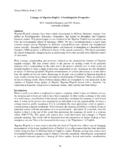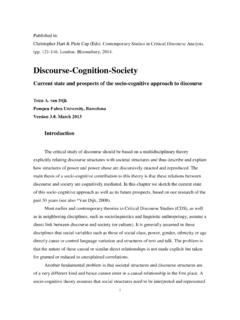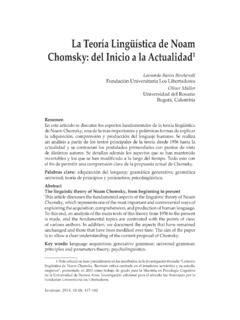Transcription of The Whole Enochian Dictionary - Archidox
1 The Whole Enochian Dictionary Introduction Do what thou wilt shall be the Whole of the Law. The Grand Experiment in the Enochian language is begun. Using etymological and qabalistic techniques to solve some of the mysteries of this language has proven to be highly rewarding. Starting off this Enochian Dictionary , we've downloaded a host of information from Wikipedia in order to educate and prepare the reader for the creative process that is to follow. Large examples of the techniques used to create this word can be found in the AOM's translations of Liber Loagaeth and further detailed in Liber Ged; of AOM origin. We've also included Aaron Lietch's excellent essay on the Enochian language and Patricia Shaffer's Letter Essences in order to create a more complete compendium for the serious student of this language. The Problem of the Schuelers Translation The Holy Table of Practice has been translated previously by published authors whose works are infamously riddled with errors.
2 There is no worse example of this than the translations of the Holy Table and Table of 12. Here the Schuelers literally make up definitions for words without any rationale at all; as if they're inventing their own game. This is really no worse than the creative yet, ridiculous efforts of the Golden Dawn to truncate the squares of the Elemental Tablets. And these irrational efforts only confound the effectiveness of this Magick. The translations here have been carefully produced by strict etymological and qabalistic practices outlined in the AOM's Liber Ged and as well, the production in Liber Loagaeth. And unlike the Schuelers, great care has been taken to explain how these translations have been produced, that the thorough student can claim confidence in his or her findings in this work. Love is the law, love under will. Enochian Grammar Linguistics is the scientific study of language, which can be theoretical or applied. Someone who engages in this study is called a linguist.
3 Theoretical (or general) linguistics encompasses a number of sub-fields, such as the study of language structure (grammar) and meaning (semantics). The study of grammar encompasses morphology (formation and alteration of words) and syntax (the rules that determine the way words combine into phrases and sentences). Also a part of this field are phonology, the study of sound systems and abstract sound units, and phonetics, which is concerned with the actual properties of speech sounds (phones), non-speech sounds, and how they are produced and perceived. Linguistics compares languages (comparative linguistics) and explores their histories, in order to find universal properties of language and to account for its development and origins (historical linguistics). Theoretical linguistics is the branch of linguistics that is most concerned with developing models of linguistic knowledge. Part of this endeavor involves the search for and explanation of linguistic universals, that is, properties all languages have in common.
4 The fields that are generally considered the core of theoretical linguistics are syntax, phonology, morphology, and semantics. Although phonetics often informs phonology, it is often excluded from the purview of theoretical linguistics, along with psycholinguistics and sociolinguistics. A linguistic universal is a statement that is true for all natural languages. For example, All languages have nouns and verbs, or All spoken languages have consonants and vowels. Research in this area of linguistics is closely tied to linguistic typology, and intends to reveal information about how the human brain processes language. The field was largely pioneered by the linguist Joseph Greenberg, who from a set of some thirty languages derived a set of basic universals, mostly dealing with syntax. Linguistic typology is a subfield of linguistics that studies and classifies languages according to their structural features. Its aim is to describe and explain the structural diversity of the world's languages.
5 It includes three subdisciplines: Qualitative typology deals with the issue of comparing languages and within-language variance, Quantitative typology deals with the distribution of structural patterns in the world's languages, and Theoretical typology explains these distributions. In linguistics, syntax (from Ancient Greek - syn-, together , and t xis, arrangement ) is the study of the rules that govern the structure of sentences, and which determine their relative grammaticality. The term syntax can also be used to refer to these rules themselves, as in the syntax of a language . Modern research in syntax attempts to describe languages in terms of such rules, and, for many practitioners, to find general rules that apply to all languages. Since the field of syntax attempts to explain grammaticality judgments, and not provide them, it is unconcerned with linguistic prescription. Though all theories of syntax take human language as their object of study, there are some significant differences in outlook.
6 Chomskian linguists see syntax as a branch of psychology, since they conceive syntax as the study of linguistic knowledge. Others ( Gerald Gazdar) take a more Platonistic view, regarding syntax as the study of an abstract formal system. Phonology (Greek (ph n ), voice, sound + (l gos), word, speech, subject of discussion), is a subfield of linguistics which studies the sound system of a specific language (or languages). Whereas phonetics is about the physical production and perception of the sounds of speech, phonology describes the way sounds function within a given language or across languages. An important part of phonology is studying which sounds are distinctive units within a language. In English, for example, /p/ and /b/ are distinctive units of sound, ( , they are phonemes / the difference is phonemic, or phonematic). This can be seen from minimal pairs such as "pin" and "bin", which mean different things, but differ only in one sound.
7 On the other hand, /p/ is often pronounced differently depending on its position relative to other sounds, yet these different pronunciations are still considered by native speakers to be the same "sound". For example, the /p/ in "pin" is aspirated while the same phoneme in "spin" is not. In some other languages, for example Thai and Quechua, this same difference of aspiration or non-aspiration does differentiate phonemes. In addition to the minimal meaningful sounds (the phonemes), phonology studies how sounds alternate, such as the /p/ in English described above, and topics such as syllable structure, stress, accent, and intonation. The principles of phonological theory have also been applied to the analysis of sign languages, even though the phonological units are not acoustic. The principles of phonology, and for that matter, language, are independent of modality because they stem from an abstract and innate grammar. Morphology is the field within linguistics that studies the internal structure of words.
8 (Words as units in the lexicon are the subject matter of lexicology.) While words are generally accepted as being (with clitics) the smallest units of syntax, it is clear that in most (if not all) languages, words can be related to other words by rules. For example, English speakers recognize that the words dog, dogs, and dog-catcher are closely related. English speakers recognize these relations from their tacit knowledge of the rules of word-formation in English. They intuit that dog is to dogs as cat is to cats; similarly, dog is to dog-catcher as dish is to dishwasher. The rules understood by the speaker reflect specific patterns (or regularities) in the way words are formed from smaller units and how those smaller units interact in speech. In this way, morphology is the branch of linguistics that studies patterns of word-formation within and across languages, and attempts to formulate rules that model the knowledge of the speakers of those languages.
9 Semantics (Greek s mantikos, giving signs, significant, symptomatic, from s ma ( ), sign) refers to the aspects of meaning that are expressed in a language, code, or other form of representation of information. Semantics is contrasted with two other aspects of meaningful expression, namely, syntax, the construction of complex signs from simpler signs, and pragmatics, the practical use of signs by agents or communities of interpretation in particular circumstances and contexts. By the usual convention that calls a study or a theory by the name of its subject matter, semantics may also denote the theoretical study of meaning in systems of signs. Though terminology varies, writers on the subject of meaning generally recognize two sorts of meaning that a significant expression may have: (1) the relation that a sign has to objects and objective situations, actual or possible, and (2) the relation that a sign has to other signs, most especially the sorts of mental signs that are conceived of as concepts.
10 Most theorists refer to the relation between a sign and its objects, as always including any manner of objective reference, as its denotation. Some theorists refer to the relation between a sign and the signs that serve in its practical interpretation as its connotation, but there are many more differences of opinion and distinctions of theory that are made in this case. Many theorists, especially in the formal semantic, pragmatic, and semiotic traditions, restrict the application of semantics to the denotative aspect, using other terms or completely ignoring the connotative aspect. Phonetics (from the Greek word , phone meaning 'sound, voice') is the study of the sounds of human speech. It is concerned with the actual properties of speech sounds (phones), and their production, audition and perception, as opposed to phonology, which is the study of sound systems and abstract sound units (such as phonemes and distinctive features). Phonetics deals with the sounds themselves rather than the contexts in which they are used in languages.









